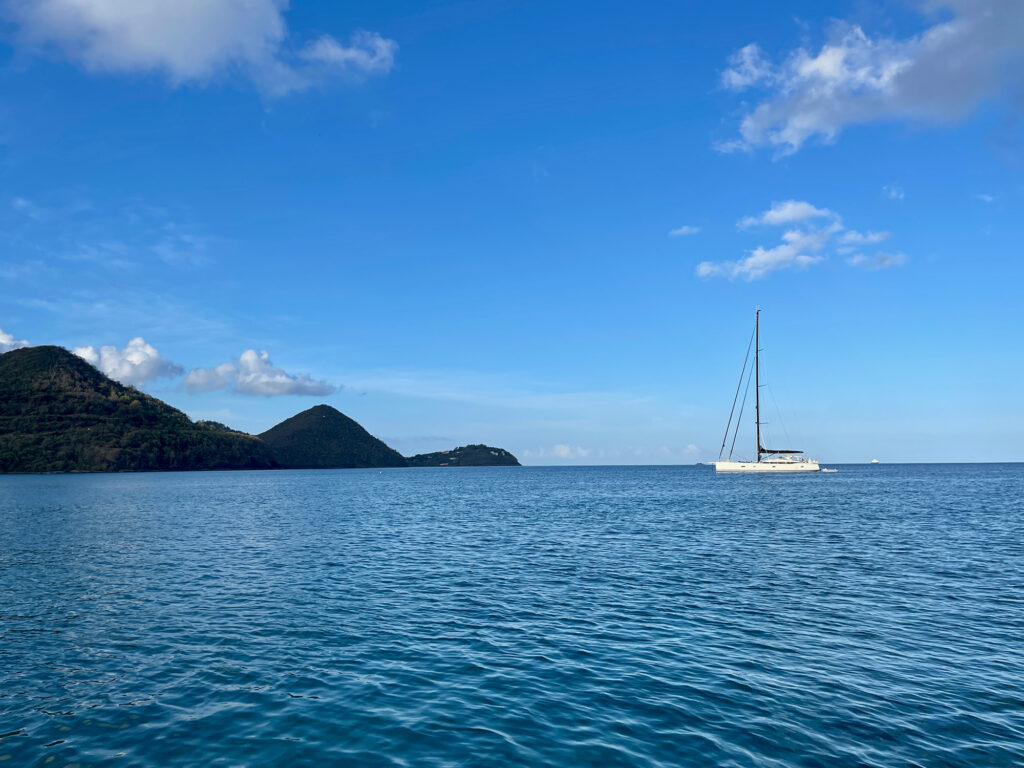
“I’m going ashore for ice,” I told Richard Thomas, owner of the Reliance 44 cutter Strider, where I was a guest. He was below, buried in the engine compartment, installing a replacement alternator. The high-output Balmar was out of commission.
Strider was at anchor this past April off the beach in St. Lucia’s Rodney Bay. Upon our arrival the day before, we had discovered the problem. Fortunately, Richard had the original alternator under a bunk up forward. He’d stowed it there after installing the new Balmar alternator during the boat’s repowering two years ago.
“Ice? Good idea,” he said. “It’s been weeks since we’ve had ice in our rum.”
Richard’s boat has refrigeration, but the freezer thermostat had shorted out when a drip from a deck fitting got into the works. There was a refrigerator box, but no way to make ice.
Is refrigeration necessary on a Caribbean boat? It’s nice, but 10 years ago, my family and I spent an entire season in the islands without it. The original Sea Frost system on Searcher, my 34-year-old Bowman 57, used a refrigerant that had become illegal in the United States. Replacing the system would have cost more than $5,000. We made do with ice, spending $700 for the entire season.
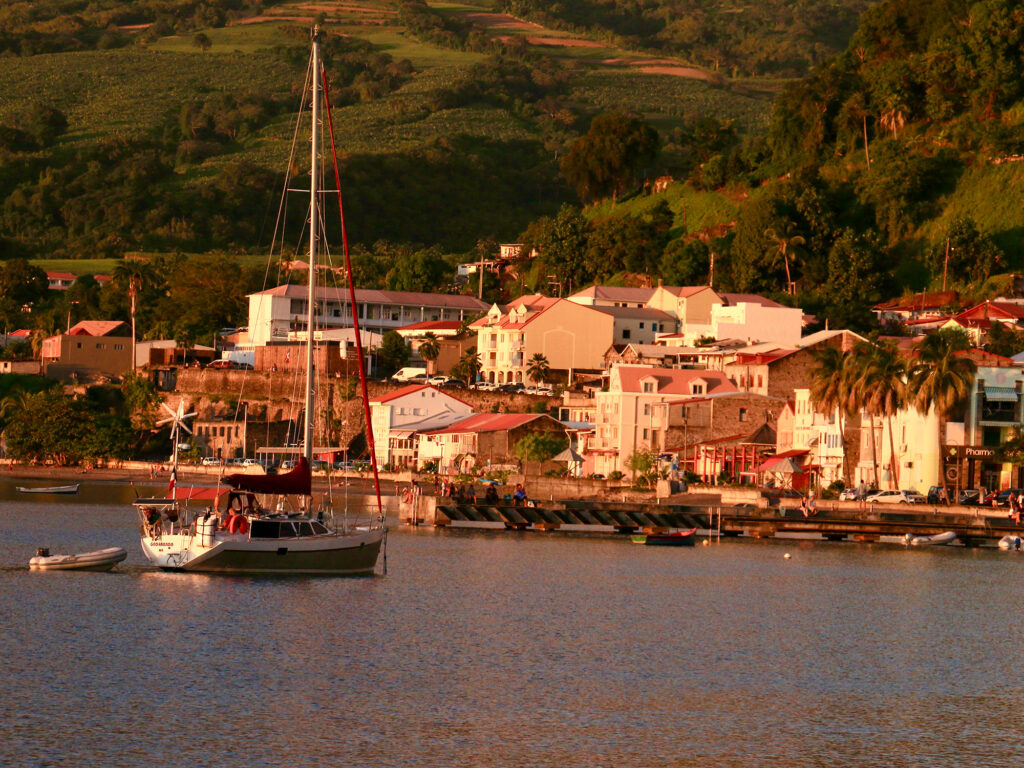
The trouble with ice in the islands is that it only comes as cubes in bags. There’s no block ice, which lasts longer. While my family and I anchored in Bequia, I’d send my 9-year-old son, Havana, ashore every afternoon in the RIB to buy a bag of ice for my evening rum, and to cool the milk and butter. Finally free from his domineering sister and parental control, he sped off to go nosing around the anchorage.
“Do your exploring on your way in to get the ice,” I’d admonish him. “Not on your way back with the ice.”
I recalled those times as I jumped into Richard’s RIB and headed ashore—but first, with a little exploring. Packed along the beach to the south was a string of all-inclusive resorts and the yacht club, like a miniature Disneyland. On the beach to the north was a community of single-story cottages, knock-together restaurants and bars, lean-to workshops, and fishing boats pulled up on the sand. A dilapidated concrete pier was the playground for a bunch of West Indian kids. I watched them jump off the pier, float, and kick a worn-out soccer ball until it went into the water. They were all fit and thin, happy to be alive. I lingered in the dinghy, just off the pier, remembering the simple joy of my youth, frolicking on the dock of our lake home in New England.
In the harbor, I found ice at the fuel dock and bought four bags. That should last us a couple of days, I figured. As I was about to head back out to the boat, I noticed a half-submerged replica of an 18th-century pirate ship—an obviously abandoned tourist party boat.
It was The Pearl, according to the nameplate on the bow. By the look of it, the boat had been there for a while. Another West Indian entrepreneurial venture comes to an end.
When I got back to the boat, the alternator was installed, and the engine was purring. “When I run up the revs,” Richard said, “the belt starts to squeal.”
“Batteries must be putting too much demand on the alternator,” I said. “I’ve had this problem on my boats. A squirt of belt treatment often works.”
Allowing the belt to squeal creates friction, which can lead to the belt’s burning out. We didn’t have an extra aboard.
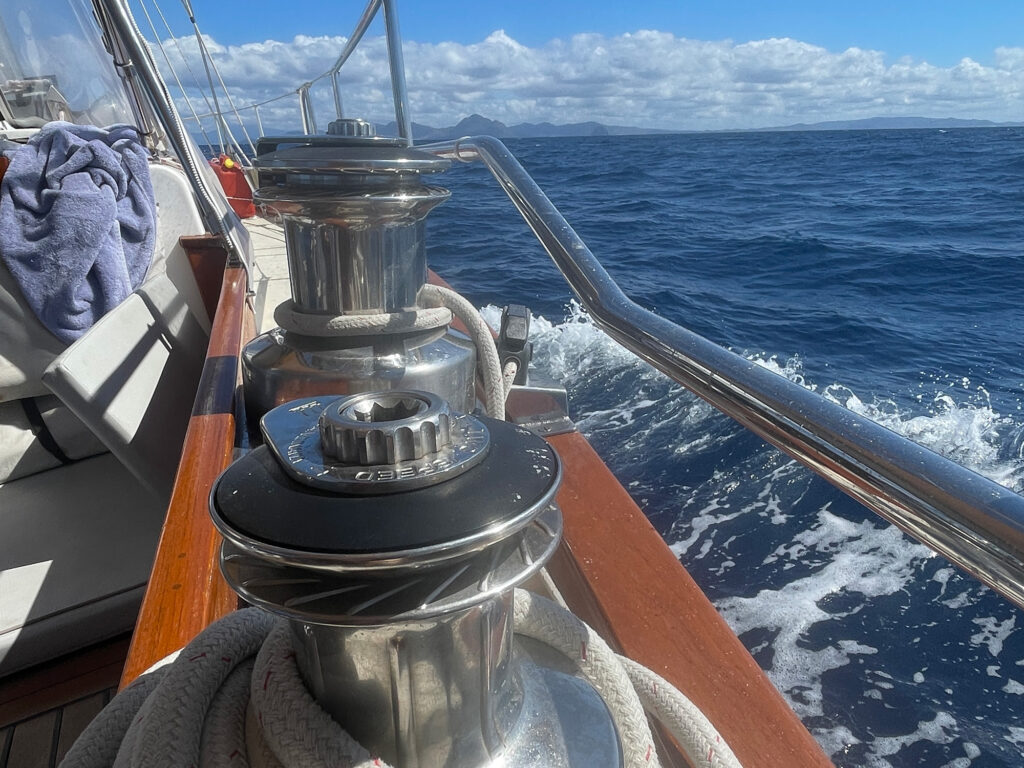
“We can’t get the batteries up to a full charge if we can’t run the engine up to 2,000 rpm,” he said.
Hmm. It was time to pour some rum and contemplate the situation.
It had been a cloudless day—ideal to photograph the setting sun. I brought up my telephoto lens and settled in on the seat at the aft rail, with my rum (now with ice) within easy reach. I’ve done this dozens of times, trying to photograph the flash of green as the top of the sun disappears below the horizon. It lasts but 125th of a second.
On this evening, conditions were right. Sahara dust, swept up in sandstorms off the deserts of North Africa, was filling the skies of the West Indies. At times, it was so thick that it looked like Maine fog, obscuring the islands just miles away. The dust was also settling, accumulating on Richard’s decks, clogging the running rigging and pissing him off. But it added a deep red to my photographs.
As I sat with my camera ready, a small catamaran crept into the scene. It was heading south, riding on the horizon, 3 miles off to the west.
It sailed right into my picture as the sun set.
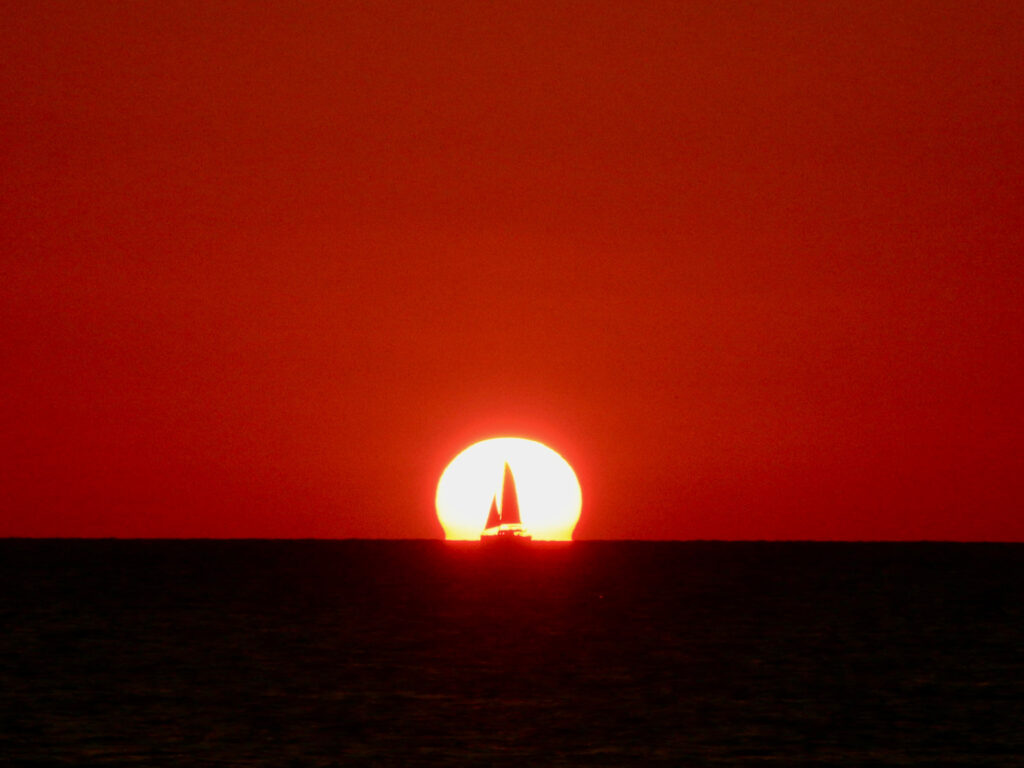
Luck? Perhaps, but as a professional photographer and one who has taught photography, I’m forever preaching that luck favors the prepared artist. In other words, be ready when the photo gods present you with a gift.
The next morning, as we got underway, the squealing began as soon as Richard got the revs above 1,000.
“We can’t go on like this!” he shouted over the noise.
“Disconnect the exciter wire to the alternator and let it freewheel,” I suggested. “Perhaps that’ll stop it.”
He did, and the squealing stopped, but the batteries weren’t charging.
“Do you think the solar cells will help?” I asked.
“We’ll hand-steer to save the batteries,” he said. “I’ll turn off the fridge. We have ice now.” Sailors are adaptable.
“I’ve got to get another Balmar alternator shipped down,” he added, “and Antigua is the best place.”
I looked at the Navionics charts on my iPhone. The distance to our next anchorage, Saint-Pierre on Martinique, was 44 miles. It would take us seven to eight hours, some of that time spent under sail. From Saint-Pierre, it would be another six hours to Portsmouth on Dominica for another night, then 47 miles, another seven hours, up to Deshaies on Guadeloupe. After that, six hours, mostly under sail, up to Jolly Harbour on Antigua.
“We’ll be in Antigua in four days,” I told Richard.
We were now ignoring a cardinal rule of cruising. We had a schedule.
By 10 a.m. that morning, we were 15 miles west of one of my favorite anchorages on these islands, Sainte-Anne on Martinique. A few years ago, at the tail end of a delivery down from Antigua, I spent two weeks there. On this trip, we’d miss it, but I felt compelled to tell Richard what we’d be missing.
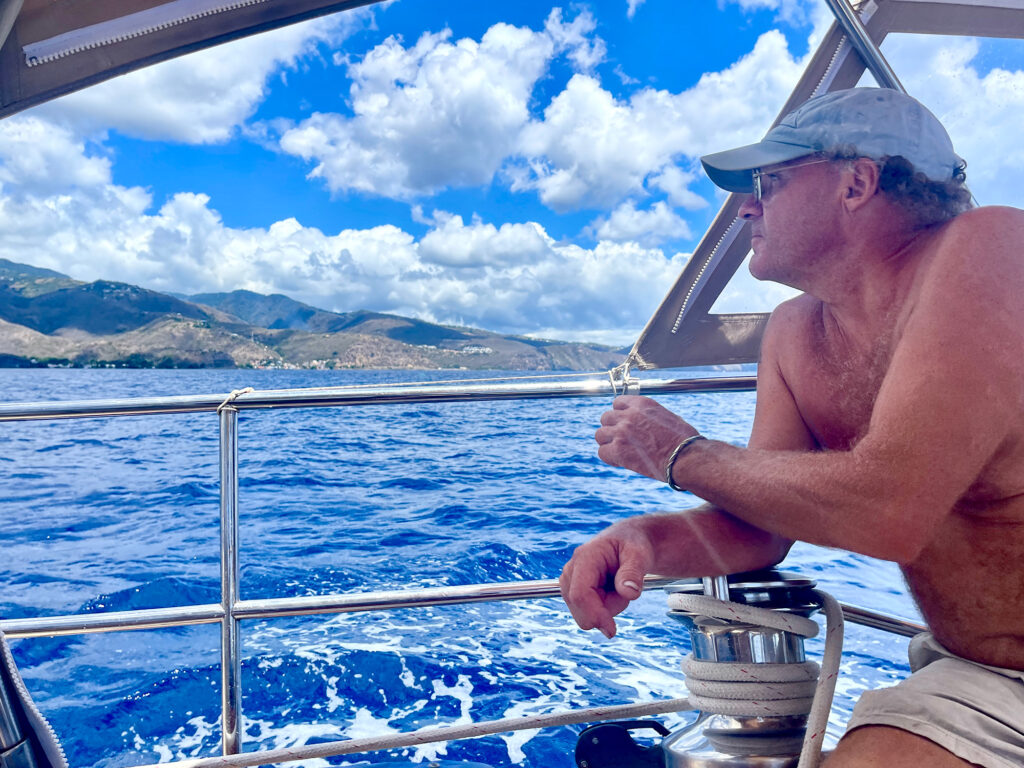
“You round Pointe du Diamant, just over there,” I said. “Then scoot between it and Diamond Rock. Ahead, there’ll be a line of white-hulled sailboats, so thick you can’t see the beach. That’s the anchorage off the village of Sainte-Anne. Marina du Marin, a huge complex, is farther up in the bay. The marinas there are full of French catamaran charter boats, but there’s an easy-in, easy-out fuel dock, and more chandleries ashore than any other place in the islands. There’s a huge supermarket in there with its own dinghy dock.”
There is little space for anchoring, though, and many of the boats appear to have been there for years, with some abandoned. I prefer Sainte-Anne’s anchorage. The water is cleaner, there’s a view of the sunset, and there’s always a breeze. It can be a bit of a dinghy ride in to the village, but there’s a substantial town dock and a garbage depository, and it’s an easy walk to the shops. There are no marine services, no fuel or water, and no chandlery.
The village has two streets, two small grocery stores, open-air fish and produce markets, and an excellent boulangerie. When I was there, a young couple from Lyon, France, had established a floating boulangerie service for boaters. Every morning, they made the rounds of the anchorage in their RIB, with tubs full of fresh croissants they made themselves, and baguettes from the shop ashore. It cost a bit more, but well worth it.
Ashore, the village of Sainte-Anne is a photographer’s paradise. I’d wander the streets, framing colorful compositions with my viewfinder. I’d linger across the street from a storefront, waiting for the actors to walk on stage and into my frame.
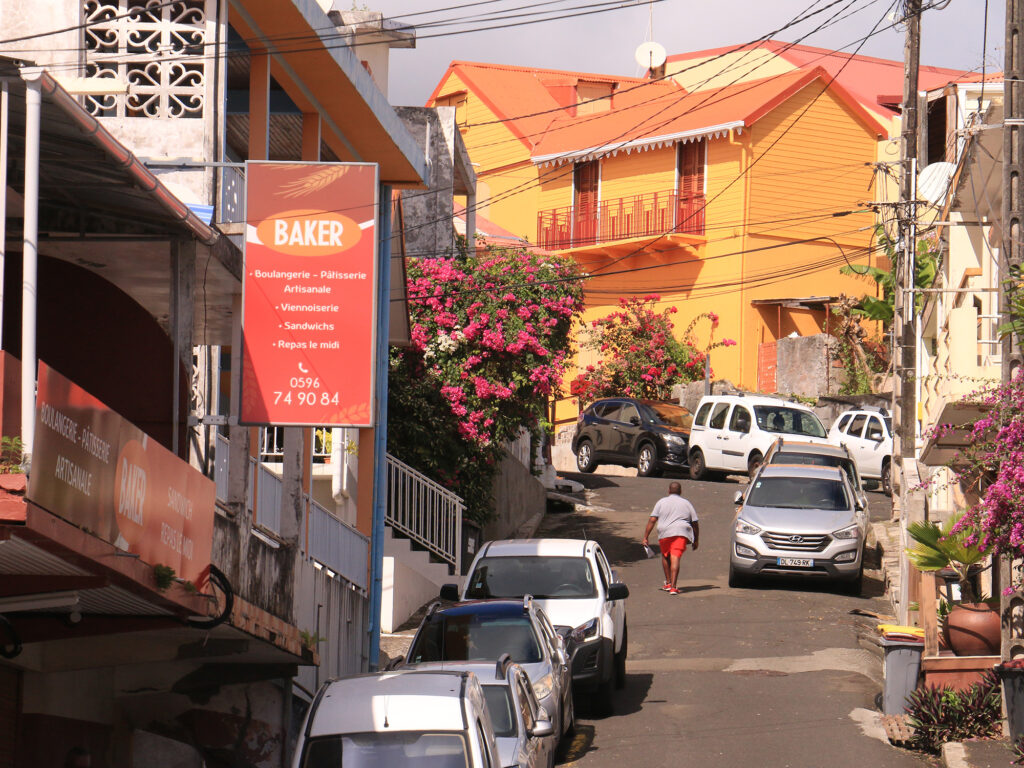
There’s a hill behind the village, with a trail to the top that begins just behind the church. It zigzags, following the 14 Stations of the Cross, with a shrine at each turn. At the top are a concrete building and cell tower—and a view of the anchorage below that’s breathtaking.
There are beaches, hiking trails and a resort nearby. Agricultural fields spread across this part of Martinique. This island is blessed with an abundance of rich volcanic soil. It exports sugar, bananas and other agricultural products, including really strong rum.
Which reminds me, back aboard Strider—it was now lunchtime. We were due west of Fort-de-France, Martinique’s commercial port, and we’d run out of wind. The mountains that run up the middle of the island were blocking the easterly trades. From these mountains, some of which rise to 4,000 feet, rivers run down gorges and valleys to spill into the sea. Doyle’s Guide describes a few small anchorages along this section of the coast. It was the last anchorage at the northern end of the island that drew us: Saint-Pierre.
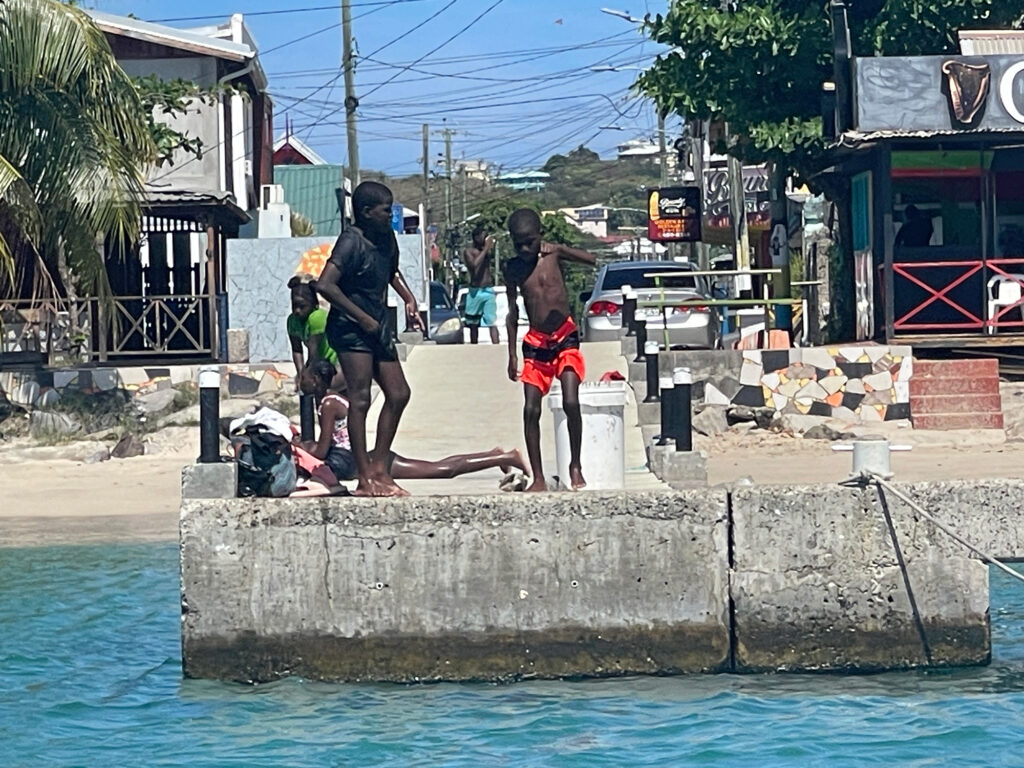
We arrived as the sun was getting ready to set, lighting up the faces of the buildings that line the beach—like a French Cubist painting. Richard found a suitable spot to anchor in 30 feet of water, just a stone’s throw from the black-sand beach. Behind the town, the summit of Mount Pelee was lost in clouds. I sat on the cabin top, a glass of rum and tonic nearby, photographing the village as the light faded into dusk and the town’s lights came on.
Years ago, the family and I went ashore here. We spent a few days exploring the island’s interior, but that’s a story for another time.








